Sir John Monash - Personal Files Book 2, 1 April - 11 April 1915, Part 1
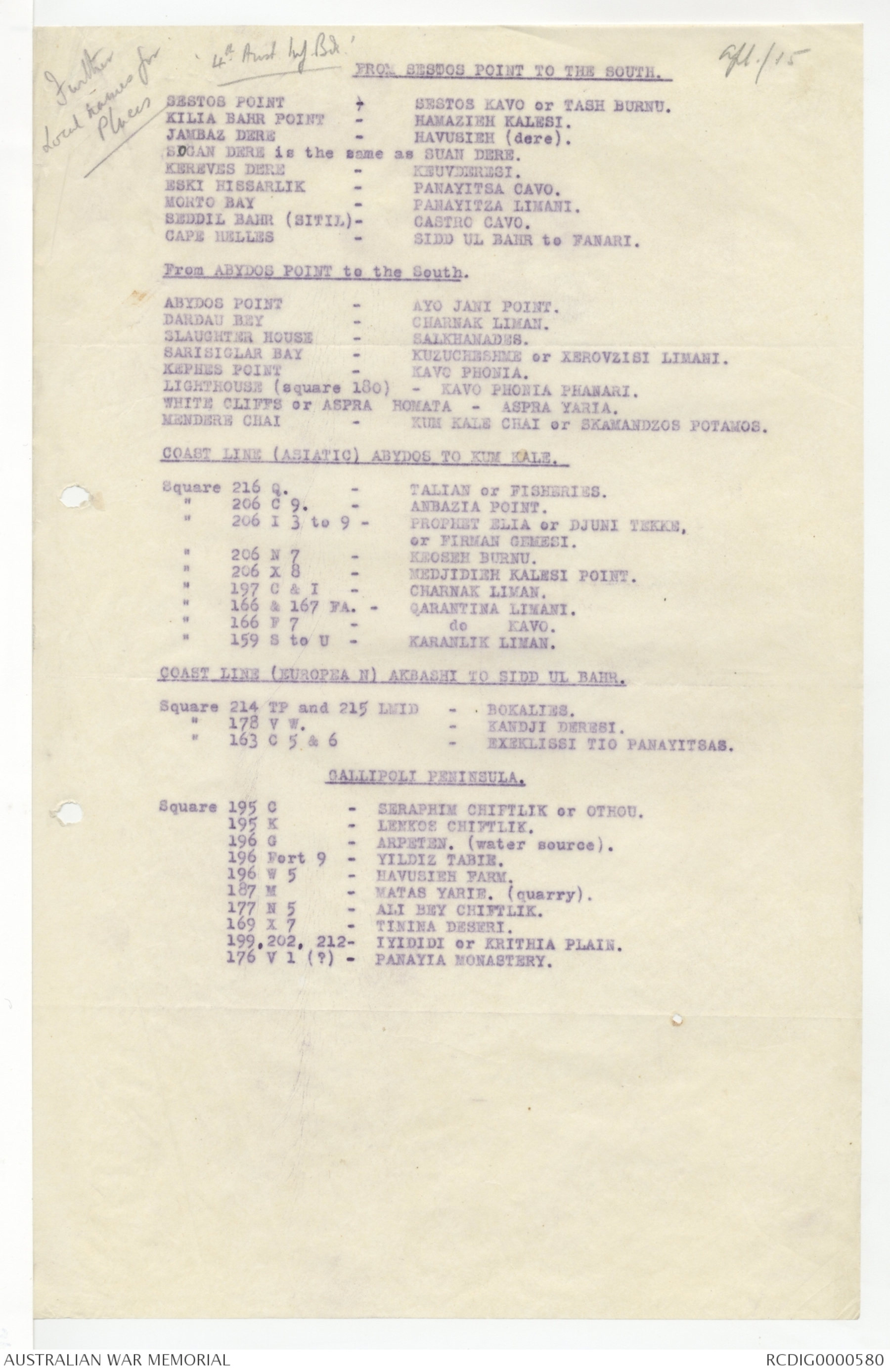
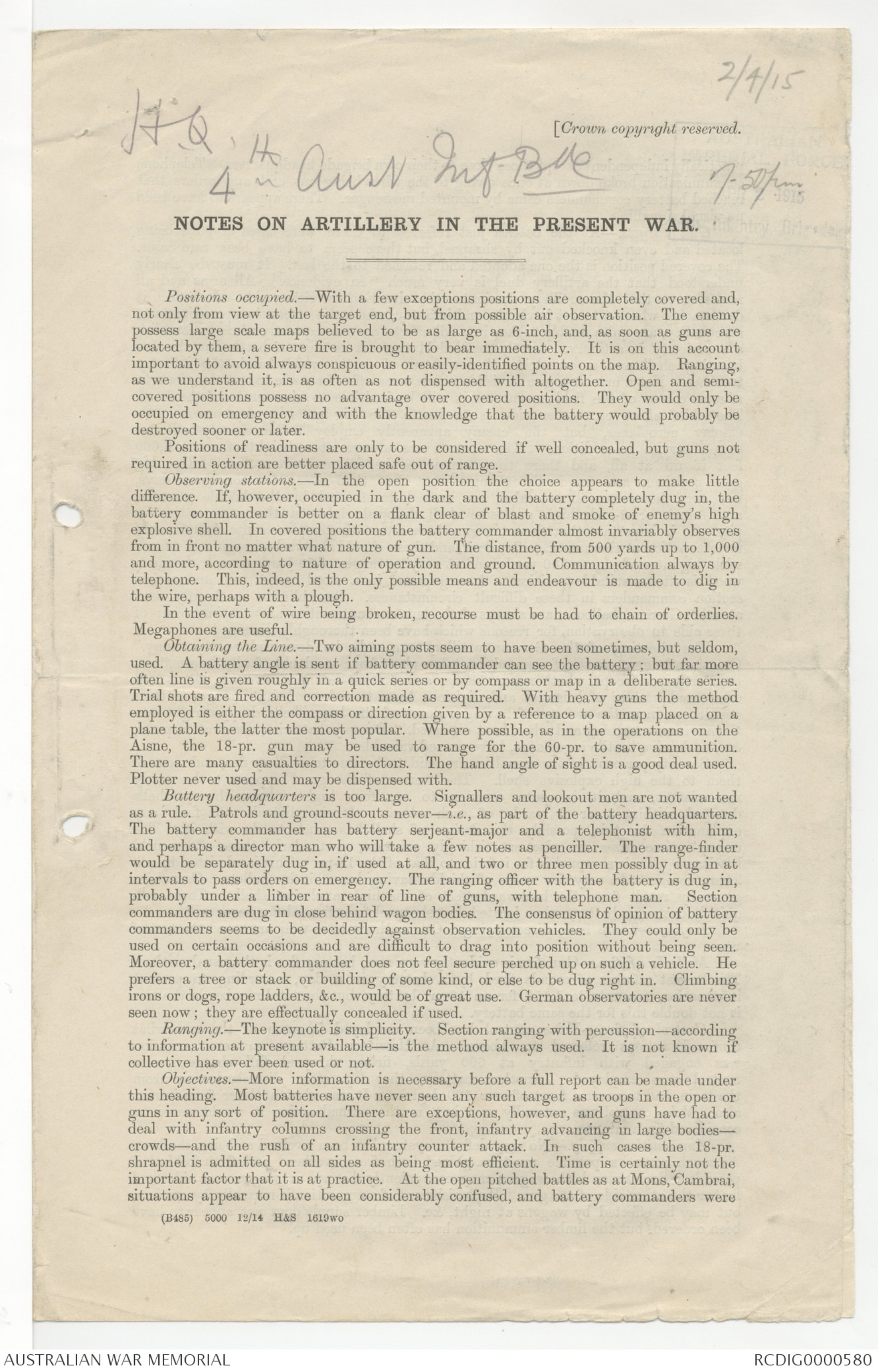
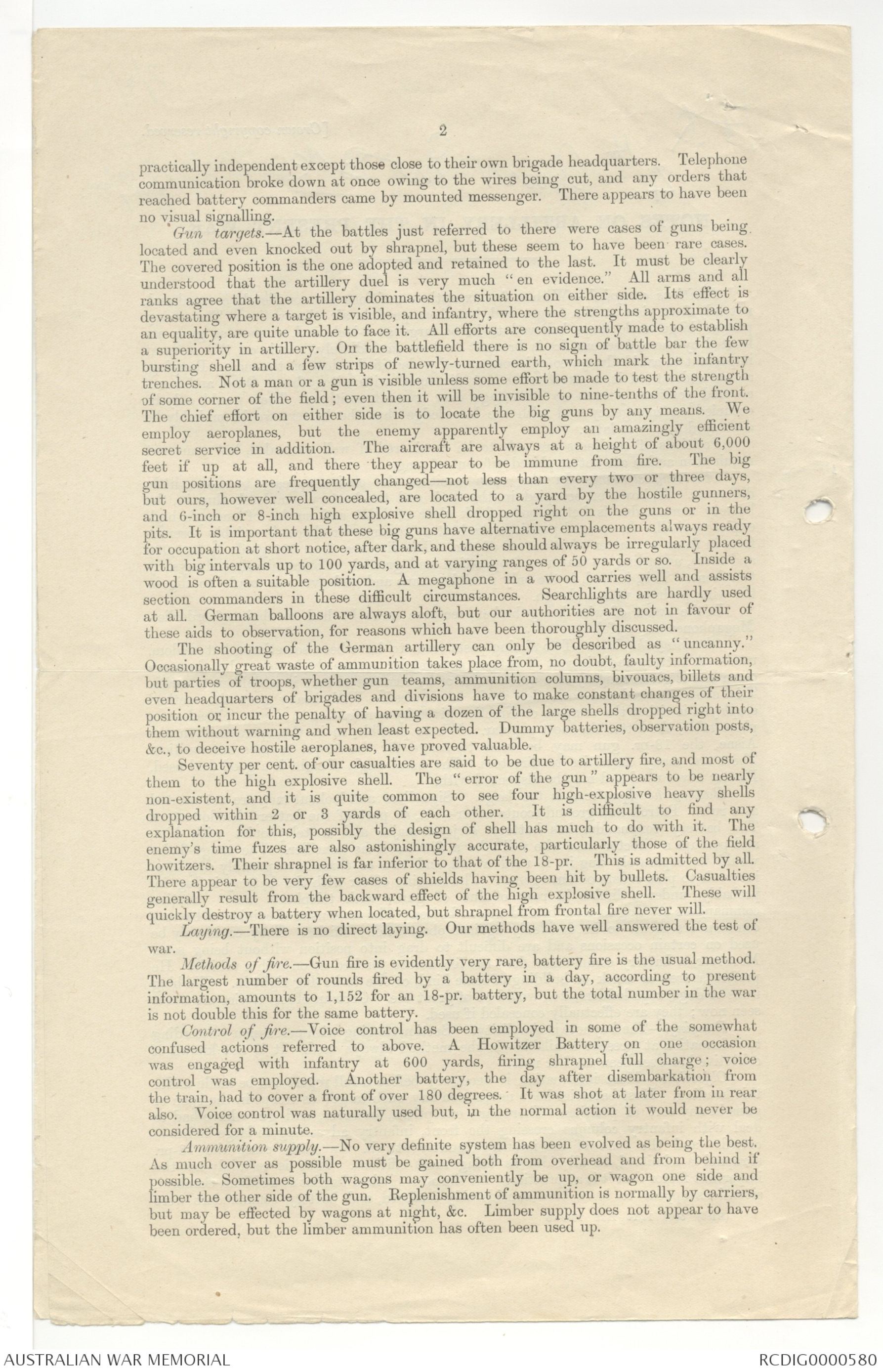
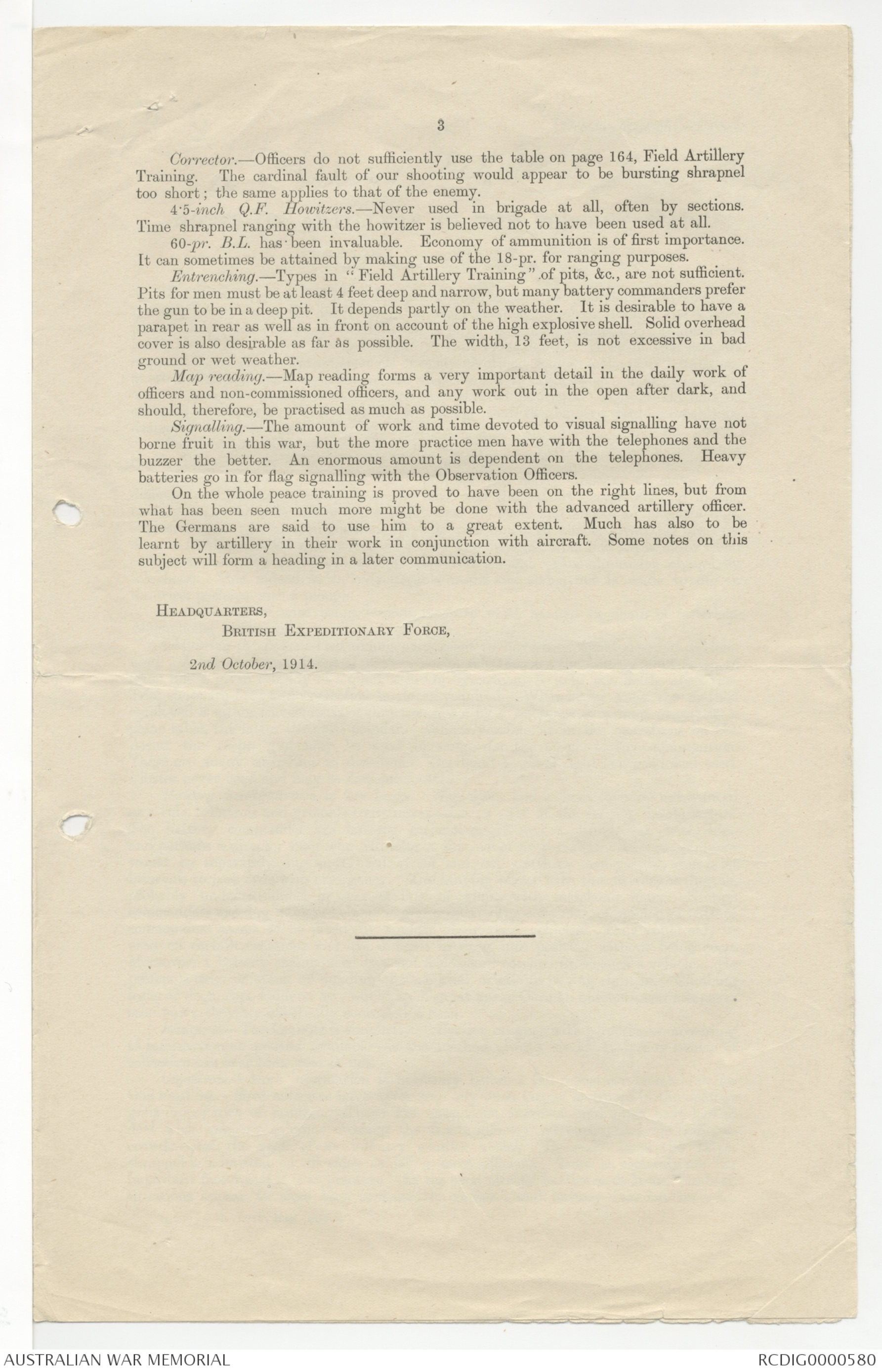
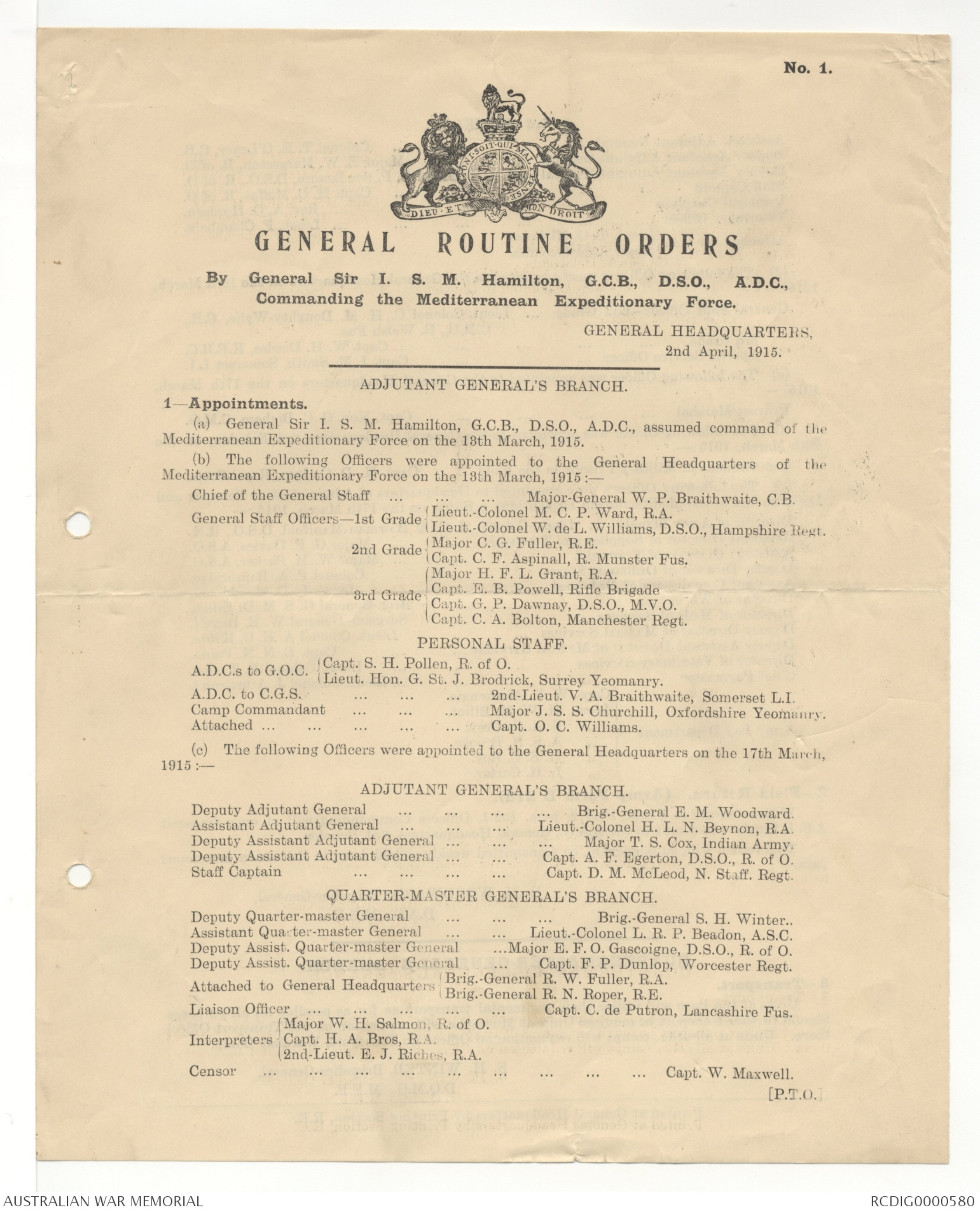
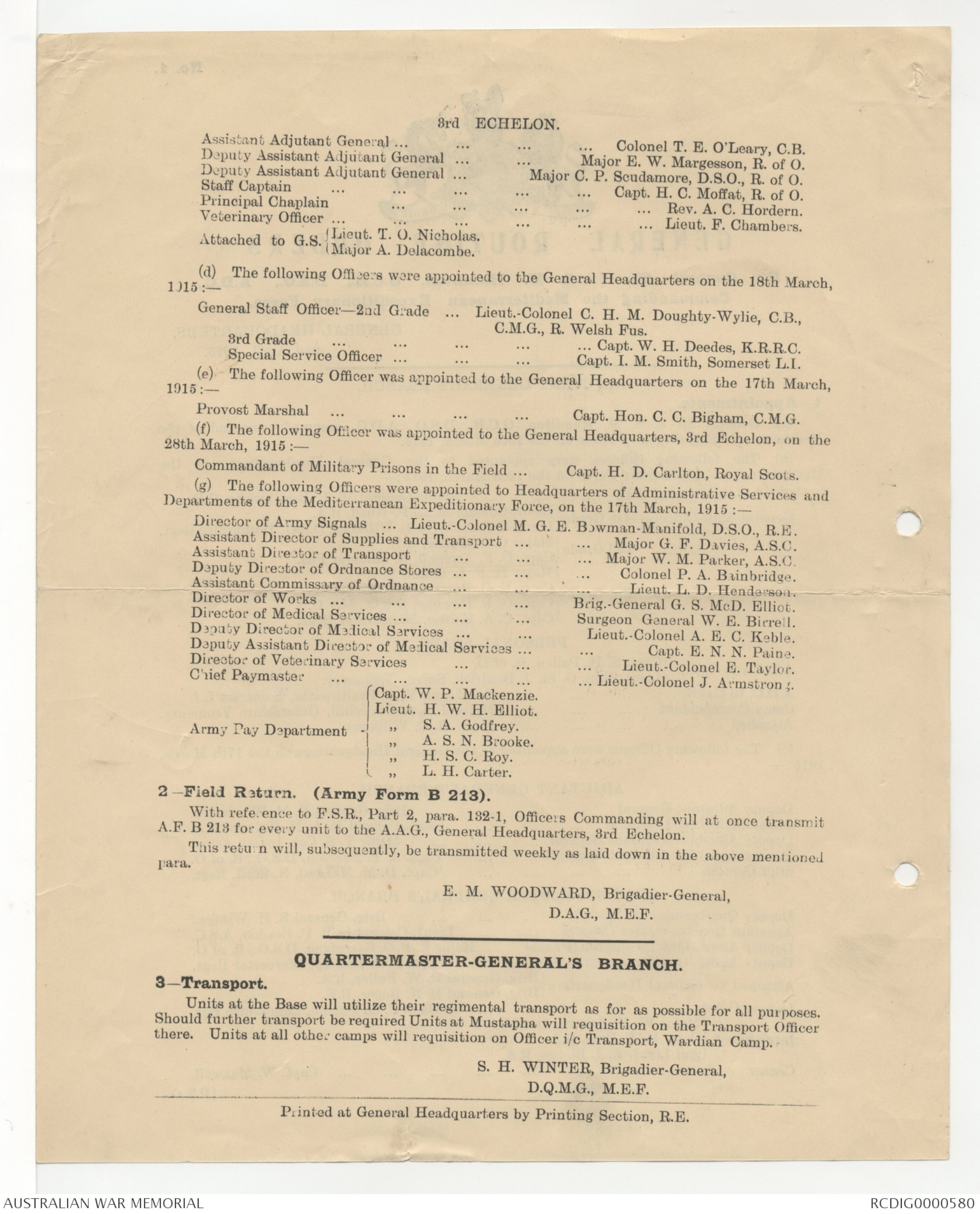
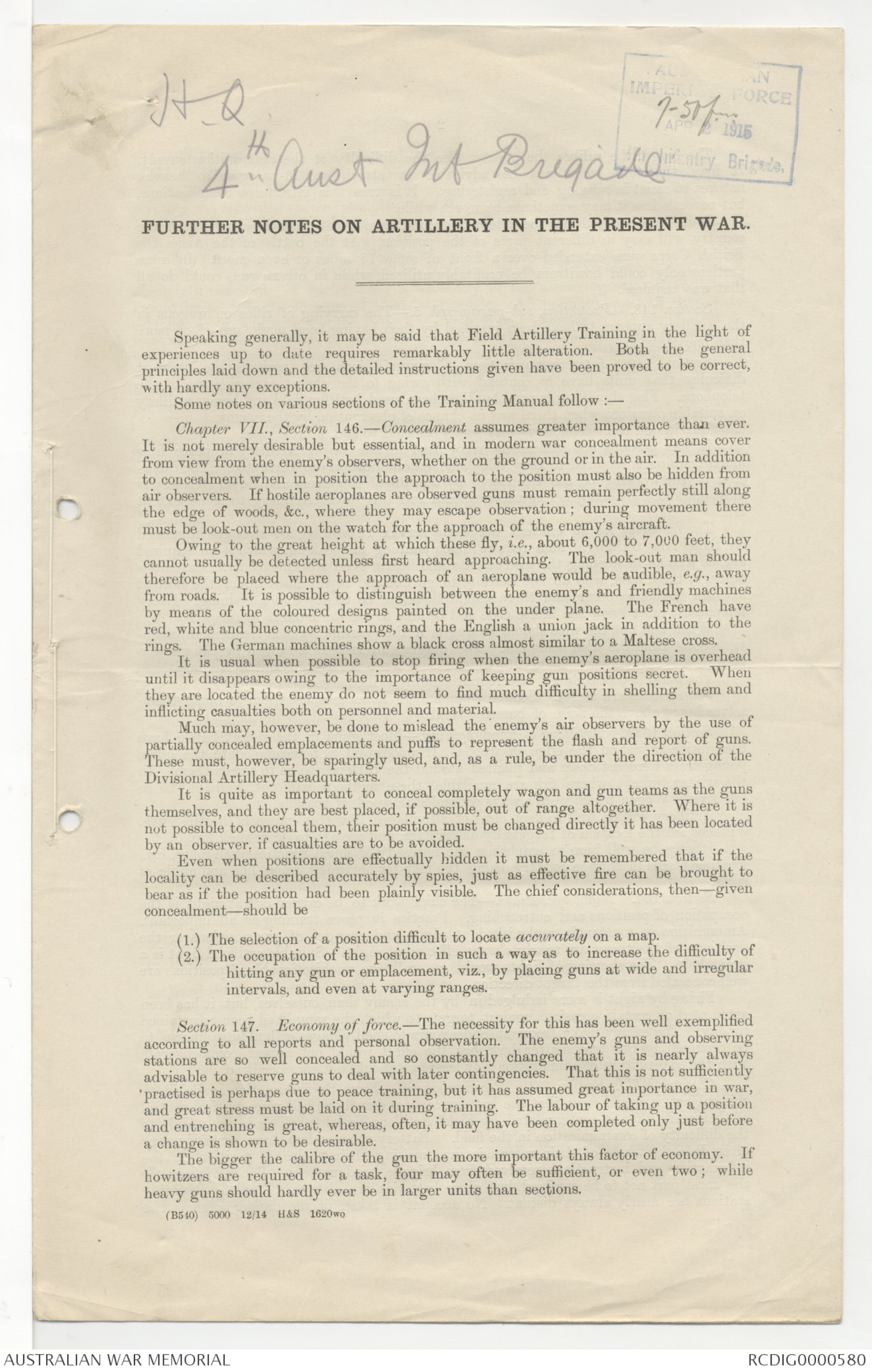
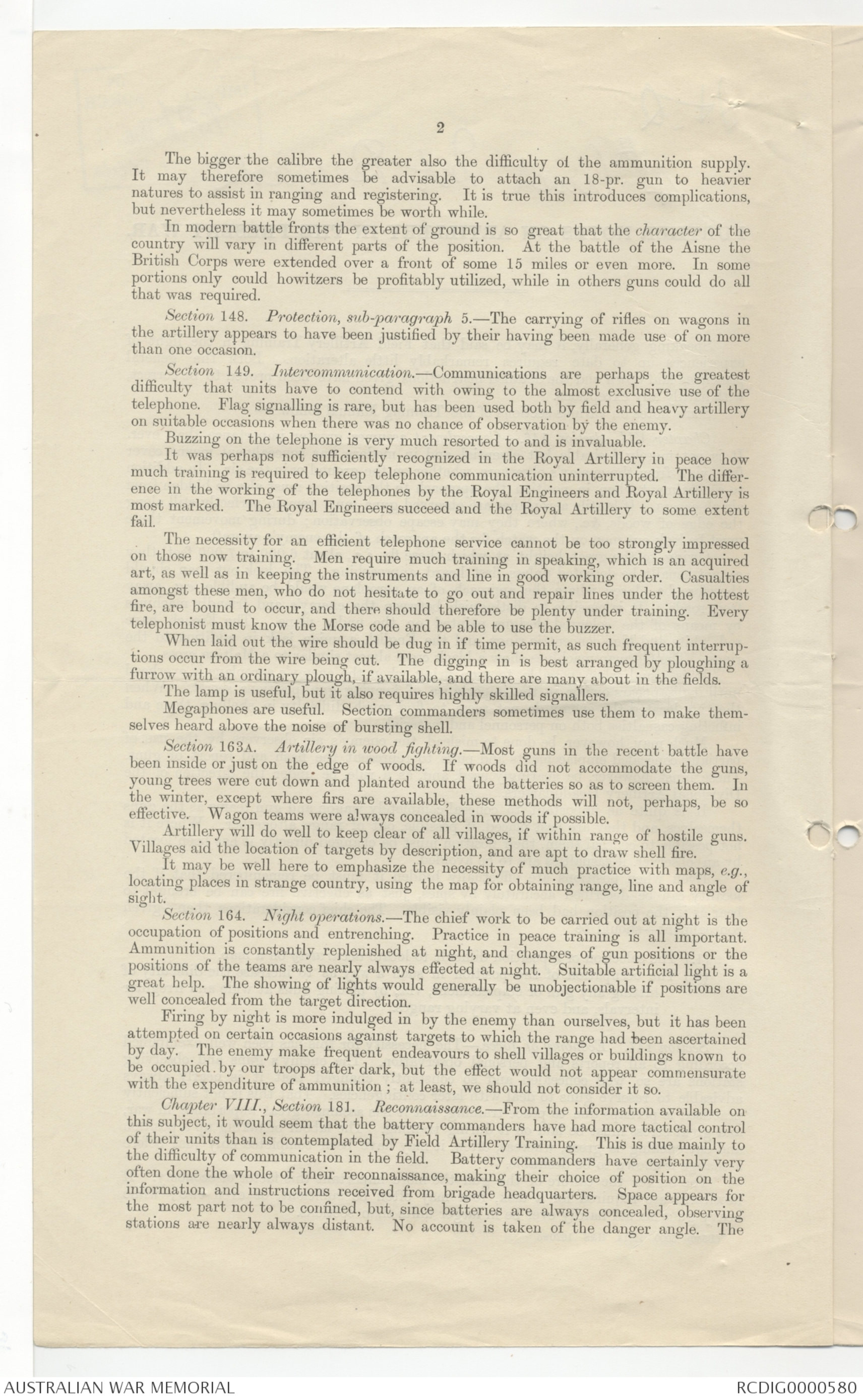
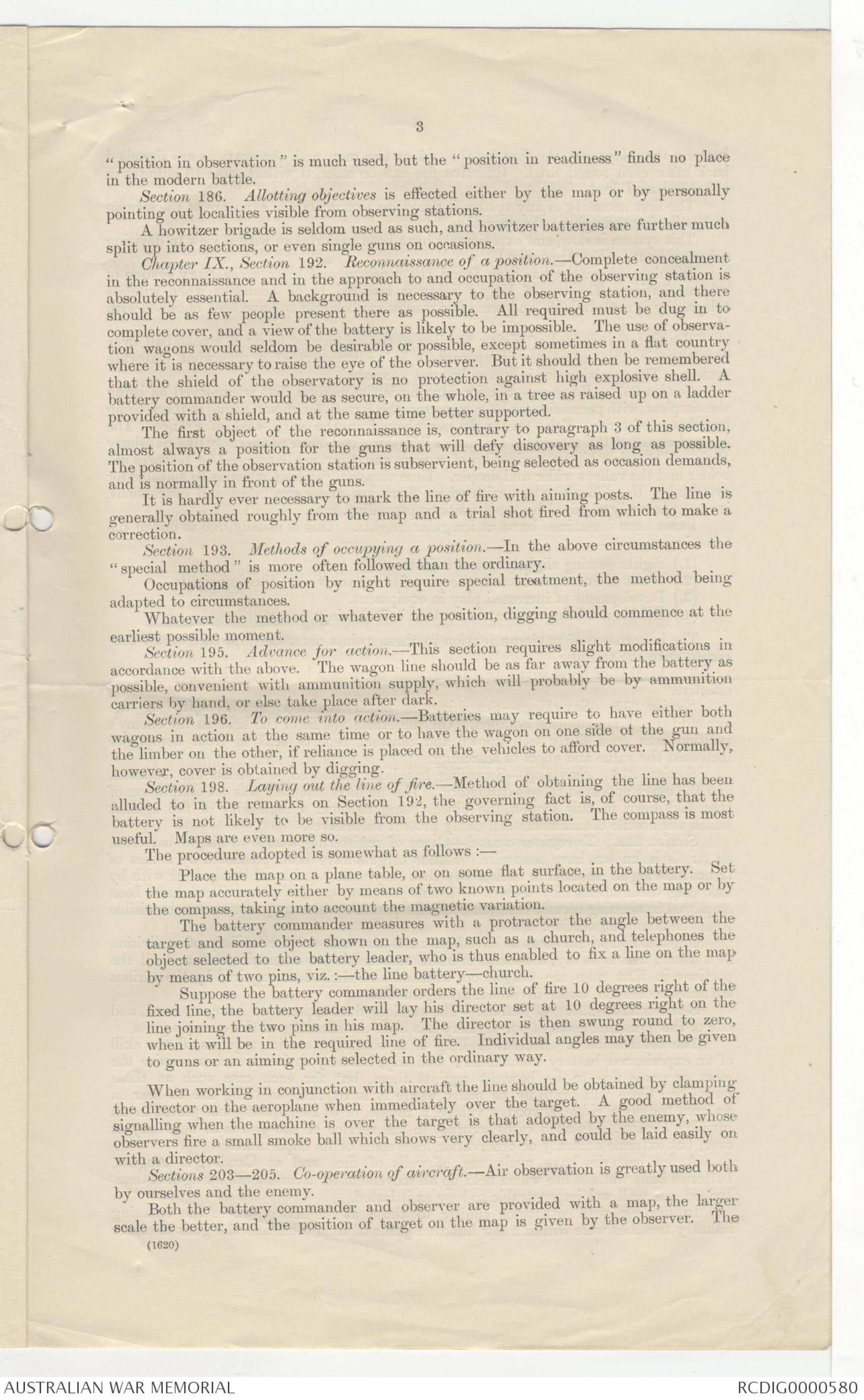
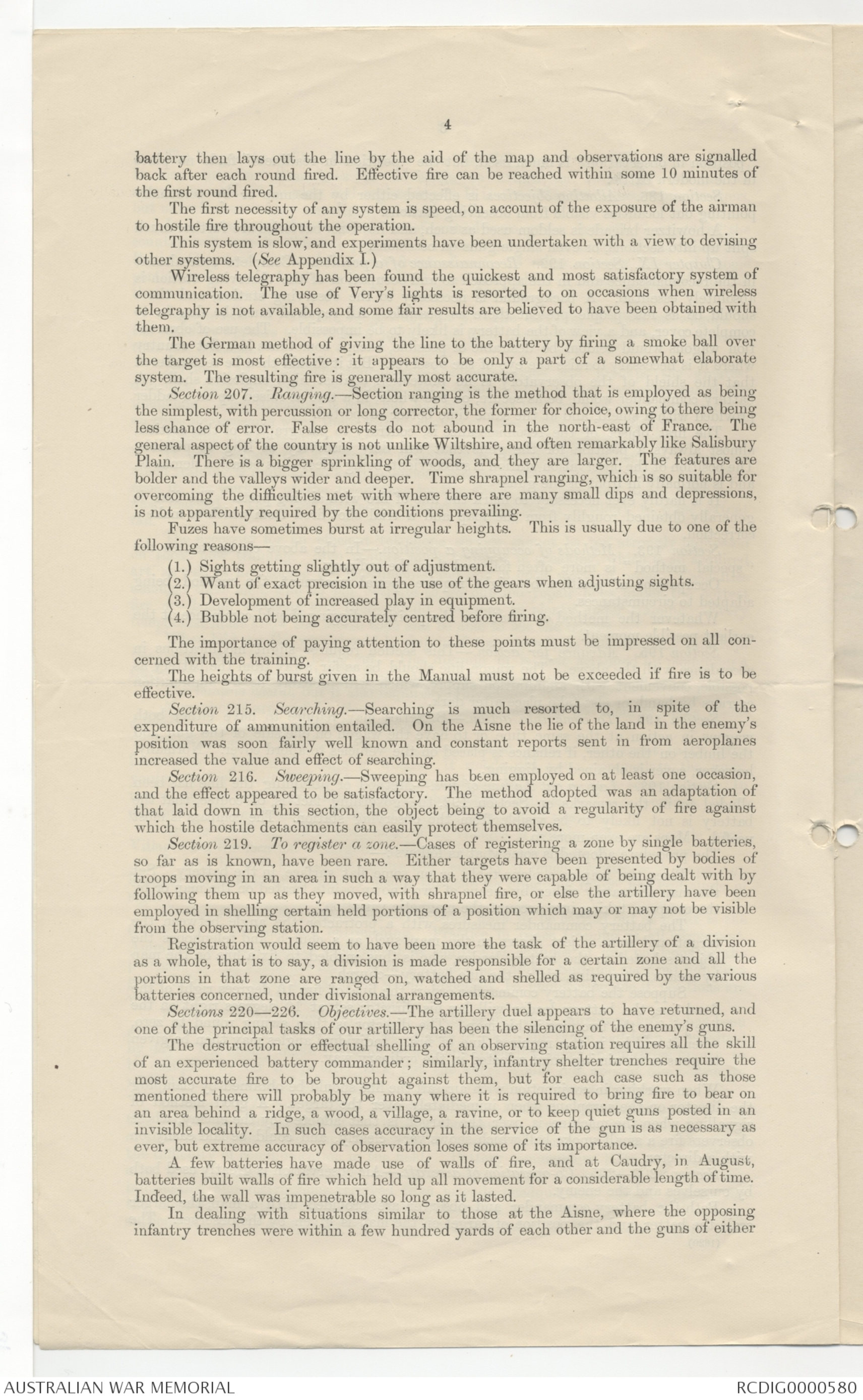
[*Further Local Names for Places*]
'4th Aust. Inf. Bde.'
Apl,/15
FROM SESTOS POINT TO THE SOUTH
SESTOS POINT - SESTOS KAVO or TASH BURNU.
KILIA BAHR POINT - HAMAZIEH KALESI.
JAMBAZ DERE - HAVUSIEH (dere).
SOGAN DERE is the same as SUAN DERE.
KEREVES DERE - KEUVDERESI.
ESKI HISSARLIK - PANAYTSA CAVO.
MORTO BAY - PANAYITZA LIMANI.
SEDDIL BAHR (SITIL) - CASTRO CAVO.
CAPE HELLES - SIDD UL HABH to FANARI.
From ABYDOS POINT to the South.
ABYDOS POINT - AYO JANI POINT.
DARDAU BEY - CHARNAK LIMAN.
SLAUGHTER HOUSE - SALKHANADES.
SARISIGLAR BAY - KUZUCHESHME or XEROVZISI LIMANI.
KEPHES POINT - KAVO PHONIA.
LIGHTHOUSE (square 180) - KVAO PHONIA PHANARI.
WHITE CLIFFS OR ASPRA HOMATA - ASPRA YARIA.
MENDERE CHAI - KUM KALE CHAI or SKAMANDZOS POTAMOS.
COAST LINE (ASIATIC) ABYDOS TO KUM KALE.
Square 216 Q. - TALIAN or FISHERIES.
" 206 C 9. - ANBAZIA POINT.
" 206 I 3 to 9 - PROPHET ELIA or DJUNI TEKKE,
or FIRMAN GEMESI.
" 206 N 7 - KOESEH BURNU.
" 206 X 8 - MEDJIDIEH KALESI POINT.
" 197 C & I - CHARNAK LIMAN.
" 166 & 167 FA. - QARANTINA LIMANI.
" 166 F 7 - do KAVO.
" 159 S TO U - KARANLIK LIMAN.
COAST LINE (EUROPEA N) AKBASHI TO SIDD UL BAHR.
Square 214 TP and 215 LMID - BOKALIES.
" 178 V W. - KANDJI DERESI.
" 163 C 5 & 6 - EXEKLISSI TIO PANAYITSAS.
GALLIPOLI PENINSULA.
Square 195 C - SERAPHIM CHIFTLIK or OTHOU.
195 K - LENKOS CHIFTLIK.
196 G - ARPETEN. (water source).
196 Fort 9 - YILDIZ TABIE.
196 W 5 - HAVUSIEH FARM.
187 M - MATAS YARIE. (quarry).
177 N 5 - ALI BEY CHIFTLIK.
169 X 7 - TININA DESERI.
199, 202, 212 - IYIDIDI or KRITHIA PLAIN.
176 V 1 (?) - PANAYIA MONASTERY.
2/4/15
[Crown copyright reserved.
H.Q.
4th Aust Inf. Bde. 7.50pm
NOTES ON ARTILLERY IN THE PRESENT WAR.
Positions occupied.—With a few exceptions positions are completely covered and,
not only from view at the target end, but from possible air observation. The enemy
possess large scale maps believed to be as large as 6-inch, and, as soon as guns are
located by them, a severe fire is brought to bear immediately. It is on this account
important to avoid always conspicuous or easily-identified points on the map. Ranging,
as we understand it, is as often as not dispensed with altogether. Open and semi-
covered positions possess no advantage over covered positions. They would only be
occupied on emergency and with the knowledge that the battery would probably be
destroyed sooner or later.
Positions of readiness are only to be considered if well concealed, but guns not
required in action are better placed safe out of range.
Observing stations.—In the open position the choice appears to make little
difference. If, however, occupied in the dark and the battery completely dug in, the
battery commander is better on a flank clear of blast and smoke of enemy’s high
explosive shell. In covered positions the battery commander almost invariably observes
from in front no matter what nature of gun. The distance, from 500 yards up to 1,000
and more, according to nature of operation and ground. Communication always by
telephone. This, indeed, is the only possible means and endeavour is made to dig in
the wire, perhaps with a plough.
In the event of wire being broken, recourse must be had to chain of orderlies.
Megaphones are useful.
Obtaining the Line.—Two aiming posts seem to have been sometimes, but seldom,
used. A battery angle is sent if battery commander can see the battery; but far more
often line is given roughly in a quick series or by compass or map in a deliberate series.
Trial shots are fired and correction made as required. With heavy guns the method
employed is either the compass or direction given by reference to a map placed on a
plane table, the latter the most popular. Where possible, as in the operations on the
Aisne, the 18-pr. gun may be used to range for the 60-pr. to save ammunition.
There are many casualties to directors. The hand angle of sight is a good deal used.
Plotter never used and may be dispensed with.
Battery headquarters is too large. Signallers and lookout men are not wanted
as a rule. Patrols and ground-scouts never—i.e., as part of the battery headquarters.
The battery commander has battery sergeant-major and a telephonist with him,
and perhaps a director man who will take a few notes as a penciller. The range-finder
would be separately dug in, if used at all, and two or three men possibly dug in at
intervals to pass orders on emergency. The ranging officer with the battery is dug in,
probably under a limber in rear of line of guns, with telephone man. Section
commanders are dug in close behind wagon bodies. The consensus of opinion of battery
commanders seems to be decidedly against observation vehicles. They could only be
used on certain occasions and are difficult to drag into position without being seen.
Moreover, a battery commander does not feel secure perched up on such a vehicle. He
prefers a tree or stack or building of some kind, or else to be dug right in. Climbing
irons or dogs, rope ladders, &c., would be of great use. German observatories are never
seen now; they are effectually concealed if used.
Ranging.—The keynote is simplicity. Section ranging with percussion- according
to information at present available—is the method always used. It is not known if
Collective has ever been used or not.
Objectives.—More information is necessary before a full report can be made under
this heading. Most batteries have never seen any such target as troops in the open or
guns in any sort of position. There are exceptions, however, and guns have had to
deal with infantry columns crossing the front, infantry advancing in large bodies—
shrapnel is admitted on all sides as being most efficient. Time is certainly not the
important factor that it is at practice. At the open pitched battles as at Mons, Cambrai,
situations appear to have been considerably confused, and battery commanders were
(B485) 5000 12/14 H&S 1619wo
2
practically independent except those close to their own brigade headquarters. Telephone
communication broke down at once owing to the wires being cut, and any orders that
reached battery commanders came by mounted messenger. There appears to have been
no visual signalling.
Gun targets.—At the battles just referred to there were cases of guns being
located and even knocked out by shrapnel, but these seem to have been rare cases.
The covered position is the one adopted and retained to the last. It must be clearly
understood that the artillery duel is very much " en evidence." All arms and all
ranks agree that the artillery dominates the situation on either side. Its effect is
devastating where a target is visible, and infantry, where the strengths approximate to
an equality, are quite unable to face it. All efforts are consequently made to establish
a superiority in artillery. On the battlefield there is no sign of battle bar the few
bursting shell and a few strips of newly-turned earth, which mark the infantry
trenches. Not a man or a gun is visible unless some effort be made to test the strength
of some corner of the field; even then it will be invisible to nine-tenths of the front.
The chief effort on either side is to locate the big guns by any means. We
employ aeroplanes, but the enemy apparently employ an amazingly efficient
secret service in addition. The aircraft are always at a height of about 6,000
feet it up at all, and there they appear to be immune from fire. The big
gun positions are frequently changed—not less than every two or three days,
but ours, however well concealed, are located to a yard by the hostile gunners,
and 6-inch or 8-inch high explosive shell dropped right on the guns or in the
pits. It is important that these big guns have alternative emplacements always ready
for occupation at short notice, after dark, and these should always be irregularly placed
with big intervals up to 100 yards, and at varying ranges of 50 yards or so. Inside a
wood is often a suitable position. A megaphone in a wood carries well and assists
section commanders in these difficult circumstances. Searchlights are hardly used
at all. German balloons are always aloft, but our authorities are not in favour of
these aids to observation, for reasons which have been thoroughly discussed.
The shooting of the German artillery can only be described as
"uncanny."
Occasionally great waste of ammunition takes place from, no doubt, faulty information,
but parties of troops, whether gun teams, ammunition columns,
bivouacs, billets and
even headquarters of brigades and divisions have to make constant changes of their
position or incur the penalty of having a dozen of the large shells dropped right into
them without warning and when least expected. Dummy batteries, observation posts,
&c., to deceive hostile aeroplanes, have proved valuable.
Seventy per cent. of our casualties are said to be due to artillery fire, and most of
them to the high explosive shell. The "error of the gun"
appears to be nearly
non-existent, and it is quite common to see four high-explosive heavy shells
dropped within 2 or 3 yards of each other. It is difficult to
find any
explanation for this, possibly the design of shell has much to do with it. The
enemy's time fuzes are also astonishingly accurate, particularly those of the field
howitzers. Their shrapnel is far inferior to that of the 18-pr. This is admitted by all.
There appear to be very few cases of shields having been hit by bullets. Casualties
generally result from the backward effect of the high explosive shell. These will
quickly destroy a battery when located, but shrapnel from frontal fire never will.
Laying.—There is no direct laying. Our methods have well answered the test of
war.
Methods of fire.—Gun fire is evidently very rare, battery fire is the usual method.
The largest number of rounds fired by a battery in a day, according to present
information, amounts to 1,152 for an 18-pr. battery, but the total number in the war
is not double this for the same battery.
Control of fire.—Voice control has been employed in some of the somewhat
confused actions referred to above. A Howitzer Battery on one occasion was engaged with infantry at 600 yards, firing shrapnel, full charge ; voice
control was employed. Another battery, the day after disembarkation from
the train, had to cover a front of over 180 degrees. It was shot at later from in rear
also. Voice control was naturally used but, in the normal action it would never be
considered for a minute.
Ammunition supply.—No very definite system has been evolved as being the best.
As much cover as possible must be gained both from overhead and from behind if
possible. Sometimes both wagons may conveniently be up, or wagon one side and
limber the other side of the gun. Replenishment of ammunition is normally by carriers,
but may be effected by wagons at night, &c. Limber supply does not appear to have
been ordered, but the limber ammunition has often been used up.
3
Corrector.—Officers do not sufficiently use the table on page 164, Field Artillery
Training. The cardinal fault of our shooting would appear to be bursting shrapnel
too short ; the same applies to that of the enemy.
4.5-inch Q.F. Howitzers.—Never used in brigade at all, often by sections.
Time shrapnel ranging with the howitzer is believed not to have been used at all.
60-pr. B.L. has been invaluable. Economy of ammunition is of first importance.
It can sometimes be attained by making use of the 18-pr. for ranging purposes.
Entrenching.—Types in “Field Artillery Training “of pits, &c., are not sufficient.
Pits for men must be at least 4 feet deep and narrow, but many battery commanders prefer
the gun to be in a deep pit. It depends partly on the weather. It is desirable to have a
parapet in rear as well as in front on account of the high explosive shell. Solid overhead cover is also desirable as far as possible. The width, 13 feet, is not excessive in bad
ground or wet weather.
Map reading.— Map reading forms a very important detail in the daily work of
officers and non-commissioned officers, and any work out in the open after dark, and
should, therefore, be practised as much as possible.
Signalling.—The amount of work and time devoted to visual signalling have not
borne fruit in this war, but the more practice men have with the telephones and the
buzzer the better. An enormous amount is dependent on the telephones. Heavy
batteries go in for flag signalling with the Observation Officers.
On the whole peace training is proved to have been on the right lines, but from
what has been seen much more might be done with the advanced artillery officer.
The Germans are said to use him to a great extent. Much has also to be
learnt by artillery in their work in conjunction with aircraft.
Some notes on this
subject will form a heading in a later communication.
HEADQUARTERS,
BRITISH EXPEDITIONARY FORCE,
2nd October, 1914.
No. 1.
GENERAL ROUTINE ORDERS
By General Sir I. S. M. Hamilton, G.C.B., D.S.O., A.D.C.,
Commanding the Mediterranean Expeditionary Force.
GENERAL HEADQUARTERS,
2nd April, 1915.
ADJUTANT GENERAL’S BRANCH
1–Appointments.
(a) General Sir I. S. M. Hamilton, G.C.B., D.S.O., A.D.C., assumed command of the
Mediterranean Expeditionary Force on the 13th March, 1915.
(b) The following Officers were appointed to the General Headquarters of the
Mediterranean Expeditionary Force on the 13th March, 1915 :—
Chief of the General Staff … … … Major-General W. P. Braithwaite, C.B.
General Staff Officers—1st Grade
(Lieut.-Colonel M. C. P. Ward, R.A.
(Lieut.-Colonel W. de L. Williams, D.S.O., Hampshire Regt.
2nd Grade
(Major C. G. Fuller, P.E.
(Capt. C. F. Aspinall, R. Munster Fus.'
3rd Grade
(Major H. F. L. Grant, R.A.
(Capt. E. B. Powell, Rifle Brigade
(Capt. G. P. Dawnay, D.S.O., M.V.O.
(Capt. C. A. Bolton, Manchester Regt.
PERSONAL STAFF.
A.D.C.s to G.O.C.
(Capt. S. H. Pollen, R. of O.
(Lieut. Hon. G. St. J. Brodrick, Surrey Yeomanry.
A.D.C. to C.G.S. … … … 2nd-Lieut. V. A. Braithwaite, Somerset L.I.
Camp Commandant … … … Major J. S. S. Churchill, Oxfordshire Yeomanry.
Attached … … … … … Capt. O. C. Williams.
(c) The following Officers were appointed to the General Headquarters on the 17th March,
1915 :—
ADJUTANT GENERAL'S BRANCH.
Deputy Adjutant General … … … … Brig.-General E. M. Woodward.
Assistant Adjutant General … … … Lieut.-Colonel H. L. N. Beynon, R.A.
Deputy Assistant Adjutant General ... … Major T. S. Cox, Indian Army.
Deputy Assistant Adjutant General … … Capt. A. F. Egerton, D.S.O., R. of 0.
Staff Captain … … … … Capt. D. M. McLeod, N. Staff. Regt.
QUARTER MASTER GENERAL'S BRANCH.
Deputy Quarter-master General … … … Brig.-General S. H. Winter..
Assistant Quarter-master General … … Lieut.-Colonel L. R. P. Beadon, A.S.C.
Deputy Assist. Quarter-master General … Major E. F. O. Gascoigne, D.S.O., R. of O.
Deputy Assist. Quarter-master General … Capt. F. P. Dunlop, Worcester Regt.
Attached to General Headquarters
(Brig. -General R. W. Fuller, R.A.
(Brig.-General R. N. Roper, R.E.
Liaison Officer … … … … … Capt. C. de Putron, Lancashire Fus.
Interpreters
(Major W. H. Salmon, R. of 0.
(Capt. H. A. Bros, R.A.
(2nd-Lieut. E. J. Riches, R.A.
Censor … … … … … … … … … Capt. W. Maxwell.
[P.T.O.]
3rd ECHELON.
Assistant Adjutant General … … … … Colonel T. E. O'Leary, C.B.
Deputy Assistant Adjutant General … … Major E. W. Margesson, R. of 0.
Deputy Assistant Adjutant General … Major C. P. Scudamore, D.S.O., R. of O.
Staff Captain … … … … … Capt. H. C. Moffat, R. of 0.
Principal Chaplain … … … … … Rev. A. C. Hordern.
Veterinary Officer … … … … … … Lieut. F. Chambers.
Attached to GS.
(Lieut. T. O. Nicholas.
(Major A. Delacombe.
(d) The following Officers were appointed to the General Headquarters on the 18th March,
1915 :—
General Staff Officer—2nd Grade … Lieut.-Colonel C. H. M. Doughty-Wylie, C.B.,
C.M.G., R. Welsh Fus.
3rd Grade … … … … … Capt. W. H. Deedes, K.R.R.C.
Special Service Officer … … … Capt. I. M. Smith, Somerset L.I.
(e) - The following Officer was appointed to the General Headquarters on the 17th March,
1915 :—
Provost Marshal … … … … Capt. Hon. C. C. Bigham, C.M.G.
(f) The following Officer was appointed to the General Headquarters, 3rd Echelon, on the
28th March, 1915 :—
Commandant of Militay Prisons in the Field ... Capt. H. D. Carlton, Royal Scots.
(g) The following Officers were appointed to Headquarters of Administrative Services and
Departments of the Mediterranean Expeditionary Force, on the 17th March, 1915 :—
Director of Army Signals ... Lieut.-Colonel M. G. E. Bowman-Manifold, D.S.O., R.E.
Assistant Director of Supplies and Transport … … Major G. F. Davies, A.S.C.
Assistant Director of Transport … … … Major W. M. Parker, A.S.C.
Deputy Director of Ordnance Stores … … … Colonel P. A. Bainbridge.
Assistant Commissary of Ordnance … … … Lieut. L. D. Henderson.
Director of Works … … … … Brig. -General G. S. MoD. Elliot.
Director of Medical Services … … … Surgeon General W. E. Birrell.
Deputy Director of Medical Services … … Lieut.-Colonel A. E. C. Keble.
Deputy Assistant Direstor of Medical Services … … Capt. E. N. N. Paine.
Director of Veterinary Services … … … Lieut.-Colonel E. Taylor.
Chief Paymaster … … … … … Lieut.-Colonel J. Armstrong.
Army Pay Department
(Capt. W. P. Mackenzie.
(Lieut. H. W. H. Elliot.
( “ S. A. Godfrey.
( “ A. S. N. Brooke.
( “ H. S. C. Roy.
( “ L. H. Carter.
2–Field Return. (Army Form B 213).
With reference to F.S.R., Part 2, para. 132-1, Officers Commanding will at once transmit
A.F. B 213 for every unit to the A.A.G., General Headquarters, 3rd Echelon.
This return will, subsequently, be transmitted weekly as laid down in the above mentioned para.
E. M. WOODWARD, Brigadier-General,
D.A.G., M.E.F.
QUARTERMASTER-GENERAL'S BRANCH.
3–Transport.
Units at the Base will utilize their regimental transport as for as possible for all purposes.
Should further transport be required Units at Mustapha will requisition on the Transport Officer
there. Units at all other camps will requisition on Officer i/c Transport, Wardian Camp.
S. H. WINTER, Brigadier-General,
D.Q.M.G., M.E.F.
Printed at General Headquarters by Printing Section, R.E.
H.Q.
4th Aust Inf Brigade
AUSTRALIAN
IMPERIAL FORCE
7-50pm
APR 2 1915
4th Infantry Brigade.
FURTHER NOTES ON ARTILLERY IN THE PRESENT WAR.
Speaking generally, it may be said that Field Artillery Training in the light of
experiences up to date requires remarkably little alteration. Both the general
principles laid down and the detailed instructions given have been proved to be correct,
with hardly any exceptions.
Some notes on various sections of the Training Manual follow :—
Chapter VII., Section 146.—Concealment assumes greater importance than ever.
It is not merely desirable but essential, and in modern war concealment means cover
from view from the enemy's observers, whether on the ground or in the air. In addition
tọ concealment when in position the approach to the position must also be hidden from
air observers. If hostile aeroplanes are observed guns must remain perfectly still along
the edge of woods, &c., where they may escape observation ; during movement there
must be look-out men on the watch for the approach of the enemy's aircraft.
Owing to the great height at which these fly, i.e., about 6,000 to 7,000 feet, they
cannot usually be detected unless first heard approaching. The look-out man should
therefore be placed where the approach of an aeroplane would be audible, e.g., away
from roads. It is possible to distinguish between the enemy's and friendly machines
by means of the coloured designs painted on the under plane. The French have
red, white and blue concentric rings, and the English a union jack in addition to the
rings. The German machines show a black cross almost similar to a Maltese cross
It is usual when possible to stop firing when the enemy's aeroplane is overhead
until it disappears owing to the importance of keeping
gun positions secret. When
they are located the enemy do not seem to find much difficulty in shelling them and
inflicting casualties both on personnel and material.
Much may, however, be done to mislead the enemy's air observers by the use of
partially concealed emplacements and puffs to represent the flash and report of guns.
These must, however, be sparingly used, and, as a rule, be under the direction of the
Divisional Artillery Headquarters.
It is quite as important to conceal completely wagon and gun teams as the guns
themselves, and they are best placed, if possible out of range altogether. Where it is
not possible to conceal them, their position must be changed directly it has been located
by an observer, if casualties are to be avoided.
Even when positions are effectually hidden it must be remembered that if the
locality can be described accurately by spies, just as effective fire can be brought to
bear as if the position had been plainly visible. The chief considerations, then—given
concealment—should be
(1.) The selection of a position difficult to locate accurately on a map.
(2.) The occupation of the position in such a way as to increase the difficulty of
hitting any gun or emplacement, viz., by placing guns at wide and irregular
intervals, and even at varying ranges.
Section 147. Economy of force.—The necessity for this has been well exemplified
according to all reports and personal observation. The enemy's guns and observing
stations are so well concealed and so constantly changed that it is nearly always
advisable to reserve guns to deal with later contingencies. That this is not sufficiently
practised is perhaps due to peace training, but it has assumed great importance in war,
and great stress must be laid on it during training. The labour of taking up a position
and entrenching is great, whereas, often, it may have been completed only just before
a change is shown to be desirable.
The bigger the calibre of the gun the more important this factor of economy. If
howitzers are required for a task, four may often be sufficient, or even two ; while heavy guns should hardly ever be in larger units than sections.
(B510) 5000 12/14 H&S 1620wo
2
The bigger the calibre the greater also the difficulty of the ammunition supply.
It may therefore sometimes be advisable to attach an 18-pr. gun to heavier
natures to assist in ranging and registering. It is true this introduces complications,
but nevertheless it may sometimes be worth while.
In modern battle fronts the extent of ground is so great that the character of the
country will vary in different parts of the position. At the battle of the Aisne the
British Corps were extended over a front of some 15 miles or even more. In some
portions only could howitzers be profitably utilized, while in others guns could do all that was required.
Section 148. Protection, sub-paragraph 5.—The carrying of rifles on wagons in
the artillery appears to have been justified by their having been made use of on more
than one occasion.
Section 149. Intercommunication.—Communications are perhaps
the greatest
difficulty that units have to contend with owing to the almost exclusive use of the
telephone. Flag signalling is rare, but has been used both by field and heavy artillery
on suitable occasions when there was no chance of observation by the enemy.
Buzzing on the telephone is very much resorted to and is invaluable.
It was perhaps not sufficiently recognized in the Royal Artillery in peace how
much training is required to keep telephone communication uninterrupted. The difference
in the working of the telephones by the Royal Engineers and Royal Artillery to some extent
fail.
The necessity for an efficient telephone service cannot be too strongly impressed
on those now training. Men require much training in speaking, which is an acquired
art, as well as in keeping the instruments and line in good working order. Casualties
amongst these men, who do not hesitate to go out and repair lines under the hottest
fire, are bound to occur, and there should therefore be plenty under training. Every
telephonist must know the Morse code and be able to use the buzzer.
When laid out the wire should be dug in if time permit, as such frequent interruptions
occur from the wire being cut. The digging in is best arranged by ploughing a
furrow with an ordinary plough, if available, and there are many about in the fields.
The lamp is useful, but it alsorequires highly skilled signallers.
Megaphones are useful. Section commanders sometimes use them to make themselves
heard above the noise of bursting shell
Section 163A. Artillery in wood fighting.—Most guns in the recent battle have
been inside or just on the edge of woods. If woods did not accommodate the guns,
young trees were cut down and planted around the batteries so as to screen them. In
the winter, except where firs are available, these methods will not, perhaps, be so
effective. Wagon teams were always concealed in woods if possible.
Artillery will do well to keep clear of all villages, if within range of hostile guns.
Villages aid the location of targets by description, and are apt to draw shell fire.
It may be well here to emphasize the necessity of much practice with maps, e.g.,
locating places in strange country, using the map for obtaining range, line and angle of
sight.
Section 164. Night operations.—The chief work to be carried out at night is the
occupation of positions and entrenching. Practice in peace training is all important.
Ammunition is constantly replenished at night, and changes of
gun positions or the
positions of the teams are nearly always effected at night. Suitable artificial light is a
great help. The showing of lights would generally be unobjectionable if positions are
well concealed from the target direction.
Firing by night is more indulged in by the enemy than ourselves, but it has been
attempted on certain occasions against targets to which the range had been ascertained
by day. The enemy make frequent endeavours to shell villages or buildings known to
be occupied by our troops after dark, but the effect would not appear commensurate
with the expenditure of ammunition ; at least, we should not consider it so.
Chapter VIII., Section 181. Reconnaissance.—From the information available on
this subject, it would seem that the battery commanders have had more tactical control
of their units than is contemplated by Field Artillery Training. This is due mainly to
the difficulty of communication in the field. Battery commanders have certainly very
often done the whole of their reconnaissance, making their choice of position on the
information and instructions received from brigade headquarters. Space appears for
the most part not to be confined, but, since batteries are always concealed, observing
stations are nearly always distant. No account is taken of the danger angle. The
3
"position in observation" is much used, but the "position in readiness" finds no place
in the modern battle.
Section 186. Allotting objectives is effected either by the map or by personally
pointing out localities visible from observing stations.
A howitzer brigade is seldom used as such, and howitzer batteries are further much
split up into sections, or even single guns on occasions.
Chapter IX., Section 192. Reconnaissance of a position.—Complete concealment
in the reconnaissance and in the approach to and occupation of the observing station is
absolutely essential. A background is necessary to the observing station, and there
should be as few people present there as possible. All required must be dug in to
complete cover, and a view of the battery is likely to be impossible. The use of observation
wagons would seldom be desirable or possible, except sometimes in a flat country
where it is necessary to raise the eye of the observer. But it should then be remembered
that the shield of the observatory is no protection against high explosive shell. A
battery commander would be as secure, on the whole, in a tree as raised up on a ladder
provided with a shield, and at the same time better supported.
The first object of the reconnaissance is, contrary to paragraph 3 of this section,
almost always a position for the guns that will defy discovery as long as possible.
The position of the observation station is subservient, being selected as occasion demands,
and is normally in front of the guns.
It is hardly ever necessary to mark the line of fire with aiming posts. The line is
generally obtained roughly from the map and a trial shot fired from which to make a
correction.
Section 193. Methods of occupying a position.—In the above circumstances the
"special method" is more often followed than the ordinary.
Occupations of position by night require special treatment, the method being
adapted to circumstances.
Whatever the method or whatever the position, digging should commence at the
earliest possible moment.
Section 195. Advance for action.—This section requires slight modifications in
accordance with the above. The wagon line should be as far away from the battery as
possible, convenient with ammunition supply, which will probably be by ammunition
carriers by hand, or else take place after dark.
Section 196. To come into action.—Batteries may require to have either both
wagons in action at the same time or to have the wagon on one side of the gun and
the limber on the other, if reliance is placed on the vehicles to afford cover. Normally,
however, cover is obtained by digging.
Section 198. Laying out the line of fire.—Method of obtaining the line has been
alluded to in the remarks on Section 192, the governing fact is, of course, that the
battery is not likely to be visible from the observing station.
The compass is most
useful. Maps are even more so.
The procedure adopted is somewhat as follows :—
Place the map on a plane table, or on some flat surface, in the battery. Set
the map accurately either by means of two known points located on the map or by
the compass, taking into account the magnetic variation.
The battery commander measures with a protractor the angle between the target
and some object shown on the map, such as a church, and telephones the
object selected to the battery leader, who is thus enabled to fix a line on the map
by means of two pins, viz. :—the line battery—church.
Suppose the battery commander orders the line of fire 10 degrees right of the
fixed line, the battery leader will lay his director set at 10 degrees right on the
line joining the two pins in his map. The director is then swung round to zero,
when it will be in the required line of fire. Individual angles may then be given
to guns or an aiming point selected in the ordinary way.
When working in conjunction with aircraft the line should be obtained by clamping
the director on the aeroplane when immediately over the target. A good method of
signalling when the machine is over the target is that adopted by the enemy, whose
observers fire a small smoke ball which shows very clearly, and could be laid easily on
with a director.
Sections 203–205. Co-operation of aircraft.—Air observation is greatly used both
by ourselves and the enemy.
Both the battery commander and observer are provided with a map, the larger
scale the better, and the position of target on the map is given by the observer. The
(1620)
4
battery then lays out the line by the aid of the map and observations are signalled
back after each round fired. Effective fire can be reached within some 10 minutes of
the first round fired.
The first necessity of any system is speed, on account of the exposure of the airman
to hostile fire throughout the operation.
This system is slow, and experiments have been undertaken with a view to devising
other systems. (See Appendix I.)
Wireless telegraphy has been found the quickest and most satisfactory system of
communication. The use of Very's lights is resorted to on occasions when wireless
telegraphy is not available, and some fair results are believed to have been obtained with
them.
The German method of giving the line to the battery by firing a smoke ball over
the target is most effective: it appears to be only a part of a somewhat elaborate
system. The resulting fire is generally most accurate.
Section 207. Ranging.—Section ranging is the method that is employed as being
the simplest, with percussion or long corrector, the former for choice, owing to there being
less chance of error. False crests do not abound in the north-east of France. The
general aspect of the country is not unlike Wiltshire, and often remarkably like Salisbury
Plain. There is a bigger sprinkling of woods, and they are larger. The features are
bolder and the valleys wider and deeper. Time shrapnel ranging, which is so suitable for
overcoming the difficulties met with where there are many small dips and depressions,
is not apparently required by the conditions prevailing.
Fuzes have sometimes burst at irregular heights. This is usually due to one of the
following reasons—
(1.) Sights getting slightly out of adjustment.
(2.) Want of exact precision in the use of the gears when adjusting sights.
(3.) Development of increased play in equipment
(4.) Bubble not being accurately centred before firing
The importance of paying attention to these points must be impressed on all concerned
with the training.
The heights of burst given in the Manual must not be exceeded if fire is to be
effective.
Section 215. Searching.—Searching is much resorted to, in spite of the
expenditure of ammunition entailed. On the Aisne the lie of the land in the enemy's
position was soon fairly well known and constant reports sent in from aeroplanes
increased the value and effect of searching.
Section 216. Sweeping.—Sweeping has been employed on at least one occasion
and the effect appeared to be satisfactory. The method adopted was an adaptation of
that laid down in this section, the object being to avoid a regularity of fire against
which the hostile detachments can easily protect themselves.
Section 219. To register a zone.—Cases of registering a zone by single batteries,
so far as is known, have been rare. Either targets have been presented by bodies of
troops moving in an area in such a way that they were capable of being dealt with by
following them up as they moved, with shrapnel fire, or else the artillery have been
employed in shelling certain held portions of a position which may or may not be visible
from the observing station.
Registration would seem to have been more the task of the artillery of a division
as a whole, that is to say, a division is made responsible for a certain zone and all the
portions in that zone are ranged on, watched and shelled as required by the various
batteries concerned, under divisional arrangements.
Sections 220–226. Objectives.—The artillery duel appears to have returned, and
one of the principal tasks of our artillery has been the silencing of the enemy’s guns.
The destruction or effectual shelling of an observing station requires all the skill
of an experienced battery commander ; similarly, infantry shelter trenches require the
most accurate fire to be brought against them, but for each case such as those
mentioned there will probably be many where it is required to bring fire to bear on
an area behind a ridge, a wood, a village, a ravine, or to keep quiet guns posted in an
invisible locality. In such cases accuracy in the service of the gun is as necessary as
ever, but extreme accuracy of observation loses some of its importance.
A few batteries have made use of walls of fire, and at Caudry , in August,
batteries built walls of fire which held up all movement for a considerable length of time.
Indeed, the wall was impenetrable so long as it lasted.
In dealing with situations similar to those at the Aisne, where the opposing
infantry trenches were within a few hundred yards of each other and the guns of either
 Jacqueline Kennedy
Jacqueline KennedyThis transcription item is now locked to you for editing. To release the lock either Save your changes or Cancel.
This lock will be automatically released after 60 minutes of inactivity.